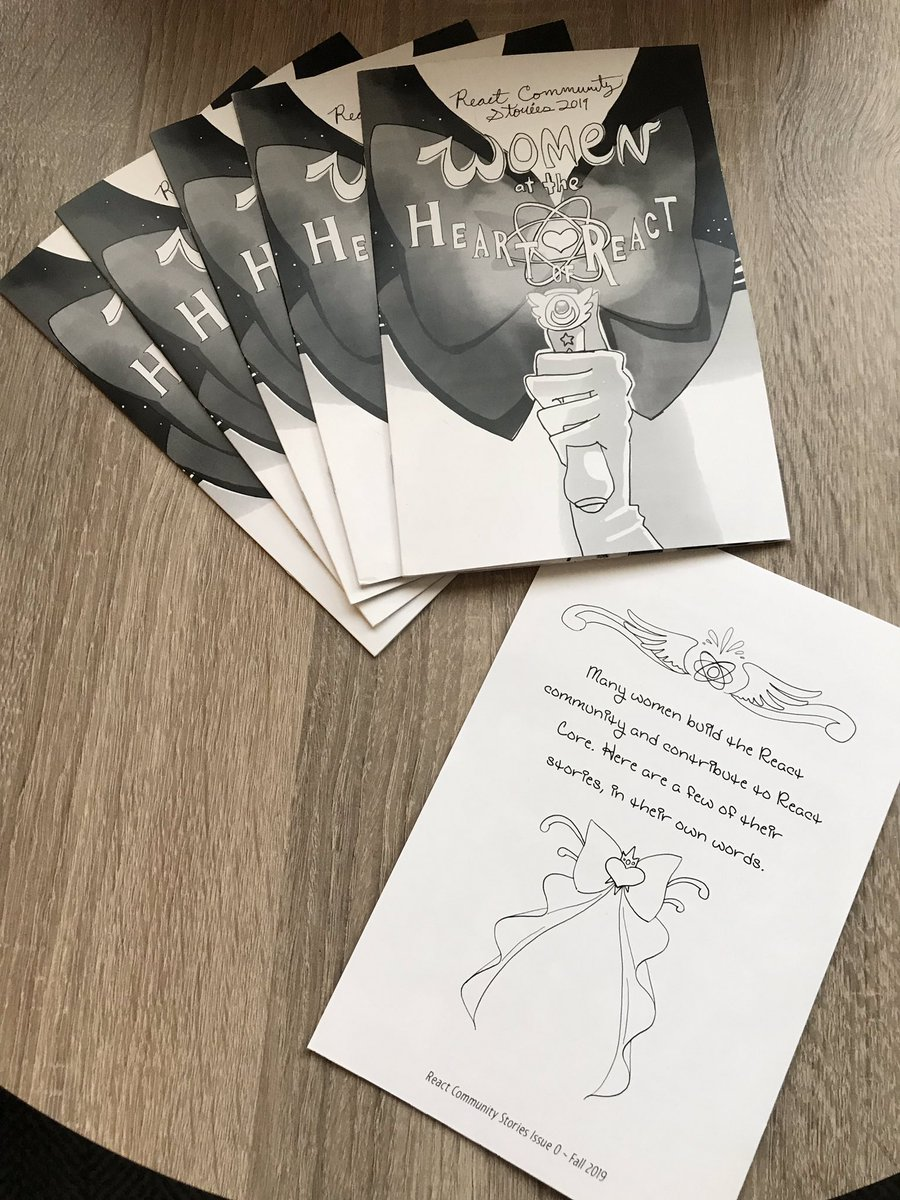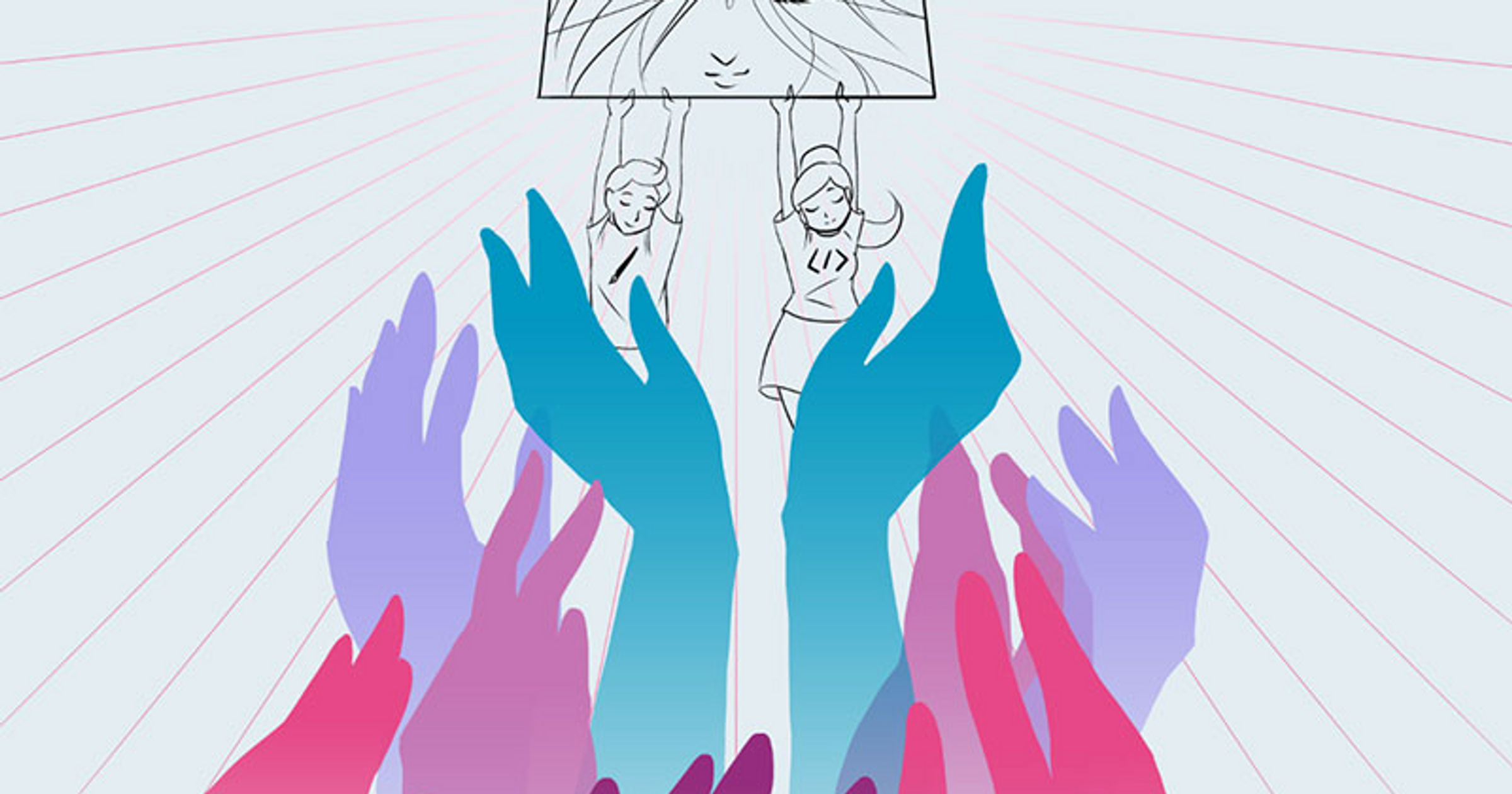Well before she managed the React community for Facebook, Rachel Nabors was building and managing groups of people. She grew up on a farm in the Blue Ridge Mountains of Virginia, homeschooled by her mother but given free reign to pursue her interests, from Egyptology to coding to cartooning. Her world started small. But access to the internet made it bigger.
She started drawing comics at age 13, and by the time she was 21, 400,000 teenage girls around the world followed her syndicated comics online. To connect with her audience, she built her own website. “My first site was a Drupal community I made to bring the world to my neck of the woods,” said Nabors. “Back then, if you wanted friends online, you had to build the clubhouse yourself.”

Since then, she’s forged a lot of paths for herself—award-winning career as a professional cartoonist, front-end developer, international speaker, CSS and web animation expert, and now helping to herd the cats as one of React community leads at Facebook. Along the way, she’s managed to build or lead in a lot of clubhouses—from a front-end dev group in Raleigh, NC, to the web animation community, she's been growing communities anywhere her career lands her. These days, with a global pandemic radically altering everyday life, she and her collaborators grew community in April around a completely online conference where women of the React community take the virtual stage—and flaunted their Animal Crossing flair.
Herding the React cats
Almost a year ago, Rachel moved to London to join the React team at Facebook. Her first task: overhauling React Native’s documentation site. “I came here to communicate some of the more complex decisions behind React and React Native paradigms to the general public.”
React, if you’re not familiar with it, is one of the most popular JavaScript front-end libraries around. Facebook created it about six years ago as an open-source alternative to existing solutions. Stack Overflow has over 200,000 questions about it, with more than 2,500 new ones asked every week.
While she has always been a quick study in tech, she has done so without a CS degree, and so she’s learned how to explain technical topics to a wide range of people. “The engineers, who are very, very smart, have been working very, very long on these projects and made many complicated decisions. Software engineers tend to communicate like, well, computer science textbooks! But I’m a cartoonist and a storyteller at heart. When you combine technical expertise with wordsmithing and illustration, you can teach anyone anything! I think the teaching success of folks like Maggie Appleton (whose talk on technical illustration was voted most popular at Women of React) demonstrates this!”
The React teams at Facebook are primarily engineering teams. They are responsible for building React and React Native, managing releases, and providing direction. React does not have the design and advocacy resources that some other technologies have. “We build React. We don’t monetize it. As such, when we engage with the community, it’s straight from the heart, from the core—from merging pull requests to speaking at conferences. It’s one of the most accessible open source teams I’ve met—and you don’t have to develop some new feature to get involved! React Native especially relies on community contributions for its documentation, making it a great place for people to start contributing, whether that’s adding a diagram or sample code.”
The React community is large and organically grown. There are tons of teachers, consultants, teams, community organizers—people from all over the world from all kinds of backgrounds all with their own opinions, ideas, values. “Sometimes people aren't sure where the React team ends and where the React community begins,” said Nabors. “I’m not the governor of the community. I don't control it. I can't say, ‘Hey, you're not being cool. Leave the clubhouse.’ I don't have that authority. No one does. But as the core team, people look to us for guidance. We are clearing things up by publicizing who is on the core team, setting expectations for how we expect community members to treat each other with our Code of Conduct, and fostering our unsung heroes with projects like Women at the Heart of React zine (a small DIY-style magazine). We can lead by example.”
The central problems of communities and documentation are similar: How do you cater to both the new users and the experts? According to a 2019 user survey, seven percent of the people who come to React Native’s documentation have no previous programming knowledge. This means iOS and Android developers learning alongside front-enders. How do you know what will work for all of these audiences? “Be friends with the experts and the beginners,” she said. “We can't take ideas like state for granted. We can't assume that the audience is already familiar with anything. I often visit workshops with people from different backgrounds at different stages in their careers. I learn so much from them.”
Luckily, Nabors isn’t alone: there are plenty of Java and Kotlin experts out there who can explain a concept clearly with all the caveats in place. She just has to pick their brains and assimilate their knowledge into a single place. “I think the hardest thing for me is all the neat things that keep flying past,” she said. “It's like, ‘No, I want to learn more about this. Wait, what's that? That looks so cool.’ It's so hard being at the nexus of so much information. You have to let it go before you're ready! The biggest change for me from my showboating-making-cool-demos phase to what I'm doing is it's not just about me anymore.”
Stepping away from being the expert, the irreplaceable centerpiece, was hard, especially since it went against a central formative experience. Nabors got her first job in tech in 2008—at the start of the recession. “It hit about two years earlier in the US than in Europe,” she remembers. She was laid off in three months. “I internalized it as something being wrong with me and worked hard to ‘prove myself.’ I walked away from that determined to become the best front-end developer ever. I felt I had to show them, to make them regret the day that they let Rachel Nabors slip through their fingers! But looking back, the whole situation had been unfair. Life is unfair often. Now I get that it wasn’t me. It was the whole situation. But if life is unfair, then it’s up to us to make it fairer.”
Throughout her career, she’s worked to signal boost other sharp women developers. In the CSS community, that was easier. Being closer to the diverse design and UX communities, women were more visible. But when she started on the React team, she asked Twitter who everyone’s favorite women in the React scene were. “The response was well, lukewarm,” she said. “I went out and did some investigation. Turns out there are a ton of women in the React community. They just don’t take the spotlight as often and their organizing network is smaller than in the communities I’ve worked with in the past. We have so many women laboring that go unnoticed, sometimes by choice.“
Signal Boosting Illustrated
Nabors wanted to tell these untold stories in a format familiar to women in comics. She debuted the Women at the Heart of React zine as a way to highlight the contributions of twelve women to React core and to organizing the React community. “I wanted to celebrate the women, both still at Facebook and those who have moved on, as well as the great organizers who have been putting together meetups and events to bring us together. Sometimes, at conferences and meetups, I'll leave the zines in the women's bathroom, and then they just all disappear.” You can read these interviews online. (Or print off your own!)

The goal has been to get more women to view React as a place that they belong, where they can contribute, where they see other women already active in the community. Nabors hopes that, with continued support and visibility, more people will find the React community a welcoming place to grow their career. “We're already starting to see a little pickup in that,” said Nabors. “I'm very happy about that. Little things like this, these little nudges, reminders that this is a shared space, that you’re not alone, growing the table, encouraging that signal boost. It goes a long way.”
Rachel was delighted to find support for these initiatives at Facebook. “I was beginning to think maybe me and big companies were not a thing,” said Nabors “I’m used to arguing at length for why these things matter. But here I found a strong culture for not just women in design and marketing but also women in engineering. I really feel a sense of belonging here, and I'm very comfy. It would be hard to dig me out.”
Facebook has a lot of mentorship programs and supportive events for women. When the North American employees had a Leadership Summit out in Menlo Park, they flew everyone from the EMEA region out to Dublin to meet and learn from each other. But it’s not just good for team building—it makes solid business sense. “Ideally, we're building Facebook for our users,” said Nabors. “It’s easier and faster to build something people love if the team mirrors the audience it’s building for. I think that there's been a lot of buy in from the top that makes a huge difference.”
The culture goes deeper than just signal boosting women; it tries to boost the voices of the people who don’t often get heard, whether that’s people of color, LGBTQ people, or even introverts. When someone says something valuable, but the conversation seems to slide over it, someone else will try to reiterate their point, crediting them with that idea. “We’re getting away from the thought of this is a me thing and getting into a this is a we thing,” said Nabors. “Realizing that some people come to the team don't have the same deck of cards that you do. You're going to have to play a different game. You’re going to have to play cooperatively, be an active player. And by teaming up together, you can play a much better hand.”
Nabors has been very active in creating that signal boost for women in the React community. Recently, she set up the Women of React conference. Even though it was conducted virtually because of the pandemic, as many as 1,400 people simultaneously tuned into the eight hour event. Cassidy Williams of Netlify (and who provides the links in our weekly newsletter) emceed the event, which had seven full talks, three lightning talks, a fireside chat and a Q&A session, plus a break for yoga.
“The event was awesome,” said Williams. “Rachel is very good at fostering a community. Whenever she hears of someone needing something, she knows that she can introduce someone to someone else, or she can help find resources or she can be a resource for someone else.” That ability to connect made this a seamless event. The A/V went off without a hitch; we’ve all seen conferences sputter when a microphone or slide deck goes awry. The speakers covered a diversity of topics, some with a creative flair. One speaker included a costume change. One had hand drawn slides. One gave a talk as a story with multiple speaking characters. (You can watch the whole conference online.)
But most importantly, it was the kind of supportive community that Rachel excels at building. “Everyone was really kind, helpful, and encouraging to all the speakers,” said Williams. “We had no code of conduct violations. We had a Discord channel set up—during every speaker, you would just see a flood of messages; ‘Oh, I like that point!’ or ‘My notebook’s getting really full.’ And after the talk, you’d see a flood of clapping emojis. It didn’t feel like a Zoom call; it felt like an actual community.”
While some of that came down to people being hungry for connections during quarantine, so much of what made this work was the logistics work that Nabors put in. Establishing clear codes of conduct, ensuring that the tech worked well, giving everyone the space to be their best. “You can tell when a conference is put on by people who are more than just passionate about the topic, but are passionate about the topic’s community and people,” said Brenda Storer, a front-end developer who attended the conference. “Women of React felt like it had a lot of heart behind it. You could feel that the organizers put a lot of thoughtful care and effort into the planning of it (which I think they did in only a few weeks!), and it has made me excited to start working with React again after a hiatus.”
The Stack Overflow blog is committed to publishing interesting articles by developers, for developers. From time to time that means working with companies that are also clients of Stack Overflow’s through our advertising, talent, or teams business. When we publish work from clients, we’ll identify it as Partner Content with tags and by including this disclaimer at the bottom.
